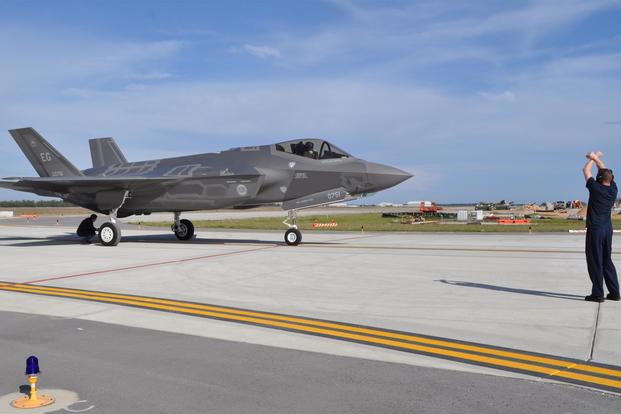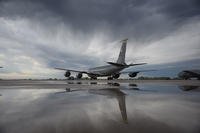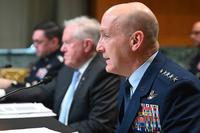EGLIN AIR FORCE BASE, Fla. -- One of the busiest F-35 Joint Strike Fighter training units is hoping the U.S. Air Force can help relieve some of the pressures of training student pilots with ineffective resources.
The 33rd Fighter Wing, the leading training wing for F-35 student pilots, hopes it will receive additional F-35A aircraft, along with considerable upgrades to its existing fleet, to keep up with training demands, said Col. Paul Moga, commander of the 33rd Fighter Wing here.
"Right now, production is king. We've got to find ways to solve this aircrew crisis, and our contribution to that is getting our students through the training program as quickly as possible," Moga said, referring to the service's ongoing pilot shortage.
Military.com sat down with Moga, head of the F-35A Lightning II flying program, during a trip accompanying Air Force Secretary Heather Wilson to the base.
Related content:
- Peeking into the Air Force's F-35 Training Course
- New Air Force Acquisitions Chief Aims to Rid F-35 of Software Glitches
- Upgrades, Development to F-35 Jet Will Cost $1 Billion Per Year
Moga said the unit has found smarter ways inside the existing structure of the 33rd to get more quality sorties into the curriculum despite limitations.
"We're the first Air Force wing to start doing what we call 'hot swaps,'" Moga said.
The term refers to different student/instructor pairs swapping out for back-to-back flights in a single aircraft in order to save time and execute more sorties.
But lately it's not enough.
"We are at the end of our rope as far as finding creative ways to generate more sorties in the same amount of daylight with the same aircraft, because you run the risk [of overunning the fleet and breaking it]," Moga said.
The 33rd maintains 25 F-35As. The U.S. Navy, which also has a presence on the base and sends pilots through the training pipeline here, keeps 8 F-35Cs on station.
The wing is authorized to have 59 aircraft.
"It stresses the system. Every single day we are maximum-performing in regards to the amount of student training that we do," Moga said.
The sustainment of F-35s at Eglin is crucial to that training mission.
Although the F-35 is the Pentagon's newest and most advanced aircraft to date, the oldest of the fleet resides at the Florida base. Moga said the planes, part of Lockheed Martin Corp.'s earliest low rate initial production batches, need the additional work.
"Everybody's aware that that fleet is on life support right now, and they need to kind of crank up the machine a little bit if they plan on extending the utility of this fleet another five or 10 years," said Moga, who also oversees the maintenance training units here.
The fifth-generation stealth plane arrived here in 2011 and made the 33rd Fighter Wing the first U.S. F-35 training unit. The first class of student pilots started training in 2013.
While Luke Air Force Base, Arizona, trains pilots in its "B course" program and flies more sorties, prospective pilots come to Eglin for its academic training center program.
Luke's curriculum requires students to train for 8 months, more than double the time of pilots coming through training at Eglin. As a result, Eglin's throughput outpaces Luke's program even though it too only trains about six pilots at a time.
Moga said officials are trying to find ways to get more sorties out of the planes they have, but they are hopeful that additional F-35As can come to the base in the future to bulk up training for their students.
"Right now, just based on our availability and our mission capable rates, it's just not possible," Moga said.
More spare parts maintenance, better software
The sustainment issues lie in the mission systems. Eglin's aircraft are "in dire need" of more mission system spare parts, the commander said.
The planes prospective pilots fly also have some of the oldest Block 2B software.
"They are the oldest software configuration outside some of the test aircraft out there," Moga said.
Moga said it could create a gap in training, as pilots who then head to Luke or Hill Air Force Base, Utah, would see newer software models.
"We can't produce a 3F graduate because we don't have any 3F aircraft," Moga said, referring to Block 3F software. The Defense Department's F-35 Joint Program Office is currently overseeing efforts to move to the even more advanced Block 4 software, which would give the F-35 a full range and larger weapons suite in combat operations sometime in the early 2020s.
The fleet here has only just now begun catching up with needed integration upgrades, Moga said.
And even if the wing received all the spare parts, a handful of aircraft are always down because they're receiving modifications or are getting depot maintenance, he added.
'Untapped resources'
Originally, Eglin was supposed to receive 107 aircraft. But in 2009, Valparaiso Mayor Bruce Arnold sued the Air Force over concerns that noise levels and increased activity would disrupt citizens living near the base.
Yet even if the wing is authorized to keep less than half of the originally planned 107, it still remains more than 20 fighters shy of what it needs.
Moga said the capacity at Eglin is there for more aircraft, with hangar space, accompanying maintenance units, and a wide range to train on.
"I just want people to be aware there are untapped resources here at Eglin and we need to start taking advantage of it," Moga said.
For example, he said, because of how the unit falls under Air Education and Training Command, there's an entire maintenance squadron that could support two units.
The base's infrastructure is only one piece of the puzzle.
If the base was in a position to get more jets, the production rate for F-35A pilots could increase. But that's only if the Air Force needs it to.
Air Combat Command, which oversees all the combat-coded squadrons in the service, would need to be ready to task and absorb those pilots if production ramps up.
"If we got 12 more jets, we could increase our training by about 60 percent," Moga said. "If we got another squadron of 24 aircraft, we could [more than] double our production."
-- Oriana Pawlyk can be reached at oriana.pawlyk@military.com. Follow her on Twitter at @oriana0214.










